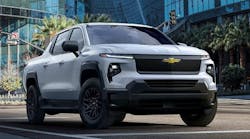General Motors Corp. executives have agreed to a partnership with Samsung SDI that will invest more than $3 billion in a battery cell manufacturing plant that will grow the automotive giant’s U.S. capacity by 23%.
The companies are not yet announcing the location of the planned facility, which will make both prismatic and cylindrical battery cells, or how many people it will employ. But officials said April 25 that “the number of new jobs in construction and operations are expected to number in the thousands.” At full production—operations are expected to begin in 2026—the plant will boost GM’s domestic battery production network to about 160 GWh.
The company’s Ohio plant is expected to reach full capacity by year’s end and facilities in Spring Hill, Tennessee (late this year) a Lansing, Michigan (next year) will soon begin cranking out batteries. All three of those plants are part of a GM joint venture with LG Energy Solution.
“The introduction of new cell form factors will allow us to expand into even more segments more quickly and integrate cells directly into battery packs to reduce weight, complexity and costs,” Executive Vice President Doug Parks said in a statement announced the Samsung SDI project, word of which comes about three months after GM and LG put on hold plans for a fourth plant. “With multiple strong cell partners, we can scale our EV business faster than we could going it alone.”
GM Chair and CEO Mary Barra and her team have set a target to have the company be on pace to produce 1 million electric vehicles by 2025. This year, that number is forecast to be 150,000. To bridge that gap, Barra on April 25 promised “more job-creating investments by GM and our suppliers, especially in North America.”
Word of the Samsung collaboration came alongside GM’s first-quarter earnings report, which was highlighted by an 11% jump in sales to nearly $40 billion and a 6% drop to $3.8 billion in adjusted earnings before interest and taxes. The latter number included an $875 million charge from the employee buyout program GM rolled out this quarter but that was essentially offset by a year-ago charge related to compensation of workers in the company’s Cruise autonomous-driving unit; the year-over-year difference was essentially due to a $180 million drop in interest income.
Speaking to analysts after the earnings report, Barra and CFO Paul Jacobson pointed out that demand for the company’s products remain robust, particularly for higher-priced trucks and SUVs. They also said GM, which last quarter temporarily paused production to keep inventory levels in line, will continue to develop more affordable models such as the Chevrolet Trax and Buick Envista as it leans on profitable premium vehicles to generate cash.
“We’re going to make our own luck,” Barra said.
Part of the plan includes ending production of the Chevrolet Bolt late this year. Consumers bought more than 38,000 Bolts last year and nearly 20,000 in the first quarter but work on the model at GM's Orion Township plant in Michigan will make way for electric versions of the Chevrolet Silverado and GMC Sierra.
Shares of GM (Ticker: GM) were down about 3% to $33.27 in midday trading April 25. Over the past six months, they have slipped about 10%, trimming the company’s market capitalization to about $47 billion.




